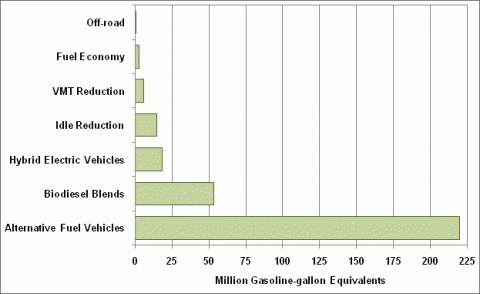Each year, estimates are made of the amount of petroleum that is displaced by the efforts of the U.S. Department of Energy's Clean Cities Program. These estimates are based on data provided by Clean Cities Coalition coordinators around the country and serve as an indicator of the impact of the coalitions. According to the program estimates, advancing the role of alternative fuel vehicles had the largest effect on petroleum – 220.1 gasoline-gallon equivalents (GGE), or 69.8% of total displacement. Using biodiesel blends instead of 100% petroleum-based diesel accounted for 53.5 GGEs, which was 17% of petroleum displacement. Other petroleum-saving approaches included using hybrid electric vehicles in the place of traditional vehicles, using idle reduction technologies and programs, vehicle miles of travel (VMT) reduction programs, fuel economy projects, and using alternative fuels in off-road equipment.
Clean Cities Petroleum Displacement Estimates, 2009
Supporting Information
| Approach | Million Gasoline-gallon Equivalents Displaced | Displacement Share |
| Using Alternative Fuels Vehicles in place of traditional vehicles | 220.1 | 69.8% |
| Using Biodiesel Blends in place of fully petroleum-based fuel | 53.5 | 17.0% |
| Using Hybrid Electric Vehicles in place of traditional vehicles | 18.1 | 5.7% |
| Idle Reduction technologies and programs, such as truck-stop electrification, onboard idle reduction, and idle reduction policies | 14.7 | 4.7% |
| VMT Reduction projects such as carpooling, work-from-home, biking, and public transportation | 5.7 | 1.8% |
| Fuel Economy projects such as low-resistance tires, trailer aerodynamics, and cylinder deactivation | 2.6 | 0.8% |
| Off-road vehicles, such as forklifts, farm equipment, and recreational equipment, using alternative fuels in place of petroleum-based fuel | 0.6 | 0.2% |
| Total | 315.3 | 100.0% |
Source: National Renewable Energy Laboratory, Clean Cities Annual Metrics Report 2009, NREL/TP-7A20-49389, November 2010. | ||


